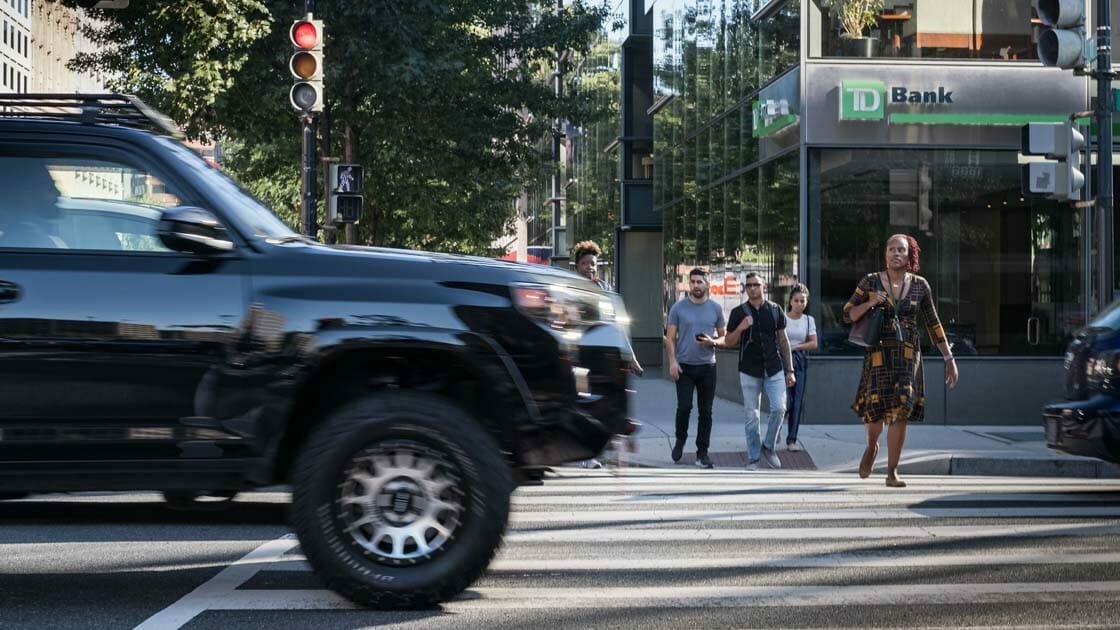
Although the designs of late-model SUVs have changed significantly over the past twenty years, a new study released by the Insurance Institute for Highway Safety (IIHS) has concluded that they are still more likely to cause pedestrian casualties than cars.
Advances in technology and safety improvements have generally resulted in safer roads for drivers and passengers. In 2018, the number of individuals killed in a motor vehicle crash in the US numbered 36,650. Compare this figure to 1980, when the number was more than 50,000. Over the past ten years, however, pedestrian casualties in the US have steadily increased.
“The number of SUVs as a proportion of total vehicles in the U.S. has grown considerably, so it’s unfortunate that they appear to cause more pedestrian casualties than cars,” said Statistician Sam Monfort of the IIHS (the lead author of the organization’s study).
In the study, researchers analyzed a sample set of 79 vehicle crashes from multiple urban areas across the state of Michigan. The conclusions show that SUVs pose a greater risk to pedestrians. However, due to the relatively small sample size of the study and the fact that it was limited to only one area of the country, more research is needed to determine if its findings are conclusive.
In the crashes analyzed from this Michigan study, pedestrians experienced more serious injuries when struck by SUVs at speeds exceeding 19 miles per hour. Between speeds of 20-39 miles per hour, 30% of crashes involving SUVs resulted in pedestrian fatalities. For crashes involving cars at this speed, fatalities numbered 23%. At speeds in excess of 40 miles per hour, 100% of the SUV incidents studied resulted in the death of a pedestrian, compared to 54% for crashes involving cars at this speed. For incidents of pedestrian-involved accidents below 20 miles per hour, no measurable difference was noted between outcomes. At these speeds, pedestrians struck by SUVs or cars tended to only sustain minor injuries.
Between 2009 and 2018, the total number of pedestrians who were killed in a motor vehicle accident rose by 53%. Over the same time frame, the number of SUVs as a relative share of passenger vehicles in the US grew to 29% from 21%, according to available vehicle registration data provided by IHS Markit, a leading research agency. Pedestrians now account for almost 20% of all vehicle-related fatalities, a share not seen since the 1980s.
IIHS studies have also shown that pedestrian-involved accidents have become both more frequent and deadlier in recent years. Although pedestrians are more often struck by cars, the number of fatal single-vehicle accidents where an SUV struck a pedestrian increased 81% between 2009 and 2016, more than any other vehicle type.
Previous studies showed that pickup trucks, SUVs, and vans were up to 3 times more likely to kill pedestrians in a crash compared to cars. However, these studies used motor vehicle accident data collected in earlier decades — the 1970s, 80s, and 90s. Since that period, SUV designs have substantially evolved for the better.
For a more modern comparison, researchers at the IIHS analyzed vehicle crash data compiled by the International Center for Automotive Medicine. Each crash that was analyzed involved a single car or SUV and one pedestrian over 13 years old. The median model year of the vehicles in the study was 2009, and 75% of them were manufactured between 2004 and 2013.
While the Michigan crashes cannot necessarily be extrapolated to measure pedestrian fatalities against SUVs across the country, the injury patterns that pedestrians experienced were consistent with previous, national studies. Specifically, they showed that pedestrians were more likely to be thrown forward and two times as likely to be left with severe hip and thigh injuries when struck by an SUV versus a car. These bodily injuries were primarily caused by impacts with headlights, grilles, or bumpers as the front profile of most newer model SUVs is considerably higher off the ground compared to the average car.
In an effort to further protect vehicle passengers, SUV manufacturers have updated their designs to be more carlike in recent years. For example, bumpers and “leading-edge” structures have been lowered to align more closely with those of cars. These design changes have led to safer roads with SUVs posing less of a threat to passengers in other vehicles compared to cars of equivalent weight.
These changes, while they better protect passengers in other vehicles, are not expected to improve casualty rates for pedestrians. When it comes to incidents involving pedestrians, where force-absorbing features are located is less important compared to the overall shape of a vehicle’s front end.
When a traditional (block-front) SUV strikes a pedestrian, the grille of the vehicle impacts the individual’s chest at virtually the same time that the SUV’s bumper hits their lower extremities. This works to transfer more energy to the body, resulting in more serious injuries. It’s possible that SUVs designed with a steeper sloping profile could cause less bodily harm.
In Europe, manufacturers have introduced features such as pedestrian airbags, which have been shown to lessen the incidence of serious injury in crashes with vehicles. However, SUVs make up a relatively smaller percentage of vehicles in Europe, so evidence proving the effectiveness of these measures is lacking.
“These findings provide further evidence that automobile manufacturers should look to make structural design changes in order to prevent more pedestrian accident and injuries, especially given the increasing popularity of SUVs,” said IIHS Senior Research Engineer Becky Mueller.
Notifications